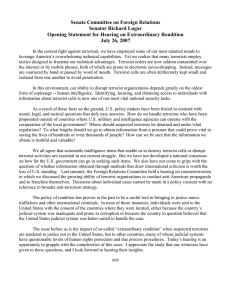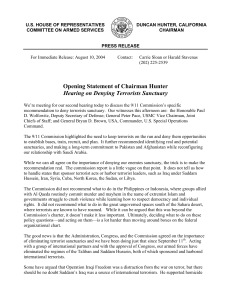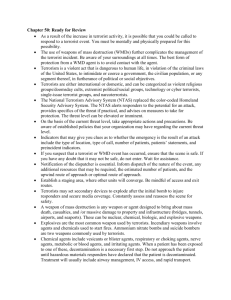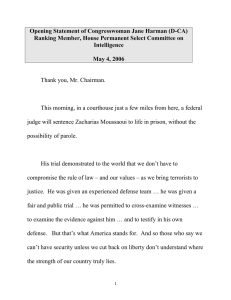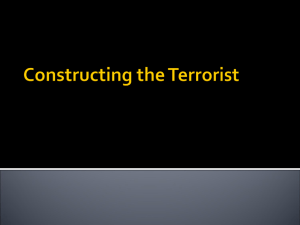ANTITERRORISM AND FORCE PROTECTION APPENDIX A
advertisement
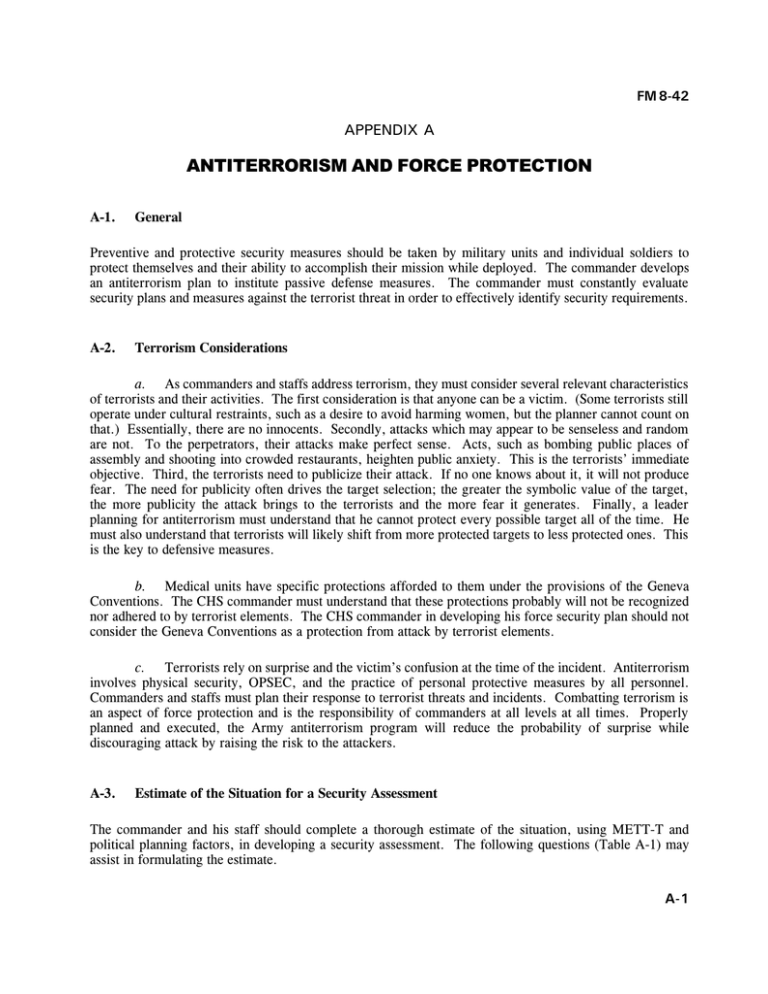
FM 8-42 APPENDIX A ANTITERRORISM AND FORCE PROTECTION A-1. General Preventive and protective security measures should be taken by military units and individual soldiers to protect themselves and their ability to accomplish their mission while deployed. The commander develops an antiterrorism plan to institute passive defense measures. The commander must constantly evaluate security plans and measures against the terrorist threat in order to effectively identify security requirements. A-2. Terrorism Considerations a. As commanders and staffs address terrorism, they must consider several relevant characteristics of terrorists and their activities. The first consideration is that anyone can be a victim. (Some terrorists still operate under cultural restraints, such as a desire to avoid harming women, but the planner cannot count on that.) Essentially, there are no innocents. Secondly, attacks which may appear to be senseless and random are not. To the perpetrators, their attacks make perfect sense. Acts, such as bombing public places of assembly and shooting into crowded restaurants, heighten public anxiety. This is the terrorists immediate objective. Third, the terrorists need to publicize their attack. If no one knows about it, it will not produce fear. The need for publicity often drives the target selection; the greater the symbolic value of the target, the more publicity the attack brings to the terrorists and the more fear it generates. Finally, a leader planning for antiterrorism must understand that he cannot protect every possible target all of the time. He must also understand that terrorists will likely shift from more protected targets to less protected ones. This is the key to defensive measures. b. Medical units have specific protections afforded to them under the provisions of the Geneva Conventions. The CHS commander must understand that these protections probably will not be recognized nor adhered to by terrorist elements. The CHS commander in developing his force security plan should not consider the Geneva Conventions as a protection from attack by terrorist elements. c. Terrorists rely on surprise and the victims confusion at the time of the incident. Antiterrorism involves physical security, OPSEC, and the practice of personal protective measures by all personnel. Commanders and staffs must plan their response to terrorist threats and incidents. Combatting terrorism is an aspect of force protection and is the responsibility of commanders at all levels at all times. Properly planned and executed, the Army antiterrorism program will reduce the probability of surprise while discouraging attack by raising the risk to the attackers. A-3. Estimate of the Situation for a Security Assessment The commander and his staff should complete a thorough estimate of the situation, using METT-T and political planning factors, in developing a security assessment. The following questions (Table A-1) may assist in formulating the estimate. A-1 FM 8-42 Table A-1. Mission, Enemy, Terrain, Troops, Time Available, and Political Planning Factors MISSION 1. 2. 3. 4. 5. WHAT TYPE OF MISSION IS TO BE CONDUCTED (SUCH AS HUMANITARIAN ASSISTANCE, NATION ASSISTANCE, DISASTER RELIEF, OR CONVENTIONAL CHS)? WHERE IS THE MISSION TO BE PERFORMED (SUCH AS WITHIN A SECURE COMPOUND, IN LOCAL VILLAGES/CITIES, IN A FIELD ENVIRONMENT)? IS THE ENTIRE UNIT OPERATING TOGETHER (SUCH AS ESTABLISHING A CLEARING STATION), OR ARE SEPARATE TEAMS BEING DEPLOYED TO REMOTE LOCATIONS (SUCH AS A TREATMENT TEAM VISITING AN ISOLATED VILLAGE)? IS THIS A MEDICAL TF MISSION WHERE CHS UNITS ARE DEPLOYED PRIOR TO COMBAT AND CS FORCES? ONCE DEPLOYED, DOES A CHANGE OF MISSION OCCUR? ENEMY (OPPOSITION GROUPS, TERRORIST FACTIONS) 1. 2. 3. 4. 5. 6. 7. WHO ARE THE POTENTIAL TERRORISTS? WHAT IS KNOWN ABOUT THE TERRORISTS? HOW DO THE TERRORISTS RECEIVE INFORMATION? HOW MIGHT THE TERRORISTS ATTACK? (THINK LIKE THE TERRORIST. WOULD YOU AMBUSH OR RAID? WOULD YOU USE SNIPERS, MORTARS, ROCKETS, AIR OR GROUND ATTACKS, SUICIDE ATTACKS, FIREBOMBS, OR BICYCLE, CAR, OR TRUCK BOMBS?) DOES THE UNIT HAVE ROUTINES OR PUBLISHED OPERATING HOURS (SUCH AS STATED CLINIC HOURS FOR THE CARE OF HN PERSONNEL)? WILL AN ATTACK GAIN SYMPATHY FOR THE TERRORISTS FROM THE POPULATION BEING SUPPORTED? WHAT IS THE PERCEIVED TERRORIST THREAT POTENTIAL FOR VIOLENCE? TERRAIN 1. 2. 3. 4. 5. WHAT ARE THE STRENGTHS/WEAKNESSES OF UNIT AREA AND LOCAL SURROUNDINGS? WHAT ARE THE AVENUES OF APPROACH? ARE THERE OBSERVATION AREAS, DEAD SPACES, FIELDS OF FIRE, ILLUMINATION, OR NO-FIRE AREAS? ARE THERE TALL BUILDINGS, WATER TOWERS, OR TERRAIN, EITHER EXTERIOR OR ADJACENT TO THE PERIMETER THAT COULD BECOME CRITICAL TERRAIN IN THE EVENT OF AN ATTACK? WHEN TEAMS MUST BE DEPLOYED TO OUTLYING AREAS TO ACCOMPLISH THE MISSION (SUCH AS PROVIDING HUMANITARIAN ASSISTANCE TO VILLAGES WITHOUT MEDICAL RESOURCES), WHAT IS THE CONDITION OF THE ROADS AND TERRAIN THAT MUST BE TRAVERSED (PAVED ROADS OR UNIMPROVED DIRT TRACKS) AND WHAT IS THE POTENTIAL FOR ATTACK WHILE IN TRANSIT? TROOPS 1. 2. 3. 4. 5. 6. 7. A-2 DETERMINE WHAT THE FRIENDLY SITUATION IS. ARE OTHER US FORCES AND EQUIPMENT AVAILABLE? ARE ENGINEERS IN THE AREA? WILL THEY BE ABLE TO PROVIDE SUPPORT? ARE MILITARY POLICE OR OTHER COMBAT/CS RESOURCES AVAILABLE TO PROVIDE FORCE PROTECTION FOR MEDICAL UNITS? ARE THERE MWD TEAMS AVAILABLE TO CONDUCT SEARCHES FOR EXPLOSIVE MATERIALS IN THE UNIT AREA? WHAT ARE THE HNS RESPONSIBILITIES, CAPABILITIES, AND ATTITUDES TOWARD PROVIDING ASSISTANCE? WHAT ARE THE ROE? FM 8-42 Table A-1. Mission, Enemy, Terrain, Troops, Time Available, and Political Planning Factors (Continued) TIME 1. 2. 3. WHAT IS THE DURATION OF THE MISSION? ARE THERE TIME CONSTRAINTS? WILL THERE BE SUFFICIENT TIME TO CONSTRUCT FORCE PROTECTION FACILITIES (SUCH AS BARRIERS AND FENCES, AND THE INSTALLATION OF LIGHTS)? POLITICAL PLANNING FACTORS 1. 2. 3. A-4. ARE THERE HN CONCERNS OR ATTITUDES WHICH WILL IMPACT ON THE SITUATION? WILL THE SITUATION BE INFLUENCED BY THE EXISTENCE OF ANY RELIGIOUS, ETHNIC, OR CULTURAL CONCERNS? IS THE ACCOMPLISHMENT OF THE CHS MISSION ALLEVIATING PART OF THE REASON FOR THE UNREST WITHIN THE COUNTRY (SUCH AS BETTER ACCESS TO HEALTH CARE OR CURBING MORBIDITY AND MORTALITY RATES FOR CHILDREN)? Force Protection and Security Measures a. Force protection is a complex process in which each action impacts upon many others. Planning for force protection is a continuous process. Force protection in stability and support operational scenarios can pose significant challenges. b. The CHS commander is responsible for providing security for his unit and the patients under his care. In some scenarios, a combat or CS unit may provide security forces to assist in the defense of CHS units. In other situations, the CHS unit may not be collocated with other types of CSS units and the CHS commander must then provide completely for his own security. c. In stability and support operations, medical units may be deployed into a given geographical area prior to the deployment of combat and CS forces. During humanitarian assistance and disaster relief operations, the perceived terrorist threat may be low, but the commander must ensure that his security measures are adequate for the appropriate threat level. Further, he must ensure he has the capability to increase these protective measures should the operational scenario change and mission creep occur. If the political, social, or economic status of the HN or region deteriorates, an increase in the potential for terrorist activity may also be experienced. The CHS commander must continuously evaluate the potential for terrorist activity and adjust his force protection plan accordingly. d. Unit and individual protective measures are discussed in detail in Joint Pub 3-07.3. A-3
